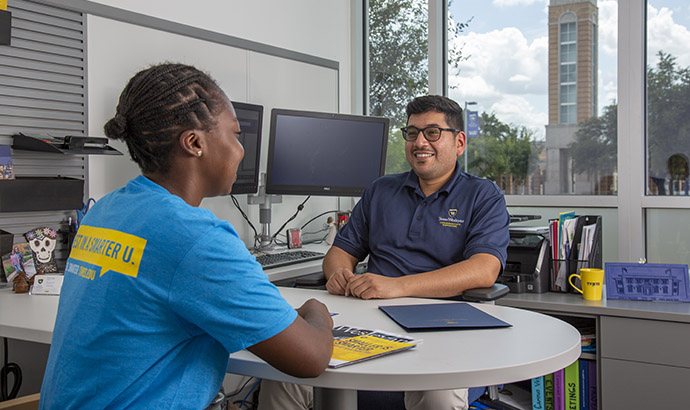There are three different styles an advisor can choose from when working with student organizations: hands-on, hands-off and a hybrid of both.
Hands-On Advising
The advisor who chooses this style is very involved in all aspects of the organization. The advisor may attend all organization meetings and take control of activities, events, and programs. While this style is very involved and time-consuming, it may be necessary for student organizations that have just been created, have large amounts of first-generation students, or students who do not have any programming experience. It is important that advisors who take this approach remember to develop the student leaders in the organization by increasingly giving students more autonomy over their programs as they learn and grow as student leaders.
Hands-Off Advising
An advisor taking this approach rarely steps into the matters of the student organization unless his or her help is needed. This style is effective when advising student organizations that are well established or have students who have experience programming. It is important for an advisor to understand the needs of an organization before taking this approach.
Hybrid
Depending on the structure or circumstances of the student organization, the advisor uses elements of the hands-on and hands-off approach.
Enser, J. (2012). Advising student programming boards. The ACPA Student Activities Journal. Retrieved from http://www.apca.com/Magazine_Flip/Individuals/Jason-Enser-newsletter.pdf
Motivating Your Student Organization
The following list includes ways advisors can help motivate the officers and members of student organizations.
Enhance Potential
Recognize the talents in each of your students, and help them reach their potential by expressing this attitude.
Give Praise
People need positive reinforcement and appreciation, so give praise when it is due.
Develop an Award System
Creating awards like “Member of the Month” help motivate organization members to participate in programs and become more involved.
Communicate
Make sure members keep you informed of organization activities, and you (as the advisor) keep members informed about activities.
Give Security
Students will look to you for advice without judgment, respect, and acceptance. As an advisor, be sure you develop a safe environment for students to come and talk to you.
Develop Purpose
Explain why your student organization members are needed, and share ways that their participation can help the organization grow.
Encourage Participation in Organization Goal Development
Include all members in the planning process, and consider their suggestions in planning.
Develop a Sense of Belonging
When students feel like they belong, they will invest more time in the organization. Make sure all students feel included and a part of the overall group.
Student Organization Retreats
Organization retreats allow student organizations to take some time away from the distractions of campus to focus on the organization and member needs. Retreats allow organization leaders to think of future goals for the upcoming year, and how to reach those goals. In addition to planning for the future, retreats allow the organization leaders to learn more about each other and to build a strong team. This section outlines briefly what advisors should do when planning a retreat for their student organizations.
Assess the Needs of the Group
What goals do you have for the students attending the retreat? Organization leaders should know why they are expected to go to the retreat and what they need to accomplish while they are there. Retreat goals may include some of the following:
- Team building
- Problem solving
- Socializing
- Building knowledge of university policies
- Officer transitions
- Communication
- Goal setting
- Leadership training
Determine the Cost of Holding a Retreat and Funding
Prepare a budget with the costs of the following items: facility rentals/room reservations, meals and refreshments, supplies, lodging (if applicable), and transportation (if applicable). Determine how the retreat should be funded. Does the organization have the money to fund a retreat? Do you need to fundraise or ask members to pay a fee to help cover costs?
Select a Retreat Site
How long do you foresee the retreat lasting? If it lasts more than a day, you may want to consider arranging overnight lodging. Would you like the retreat to be held on campus or off campus? Possible locations include local camps, hotels, parks, or campus facilities.
Develop Member Ownership in the Retreat
Establish committees to work on different parts of the retreat. For example, have separate committees handle transportation, food, recreation, agenda, speakers, and clean up. When the members are involved, then the retreat will be more successful.
Plan the Agenda
Make sure the agenda is planned ahead of time, and be sure to include free time. Items to consider on an agenda include workshops, exercises, team building activities, and games. Determine how much time you would like to dedicate to each item and order of events. Send the agenda out to members or officers going to the retreat, so the students know what to expect.
Choose Facilitators
When determining facilitators for the retreat think about the following: qualifications to share the information covered, abilities to assess situations, listening skills, concern for the group, and if he/she is respected by the group. Facilitators could be advisors, officers, members, or outside people. Make sure the facilitators you choose know the schedule of events, and are available to speak to your group.
Evaluate the Retreat
Conduct an evaluation at the end of the retreat. Ask attendees about their overall experience, their thoughts on sessions and exercises, what aspects of the retreat they would change, and aspects of the retreat they would keep the same. Be sure to include closure activities to wrap up the retreat and allow attendees to review what they learned.







